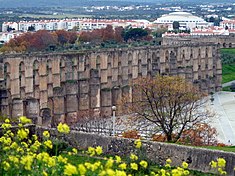Amoreira Aqueduct
| Amoreira Aqueduct (Aqueducto da Amoreira) | |
| Aqueduct (Aqueducto) | |
| Official name: Aqueducto da Amoreira | |
| Named for: Mulberries | |
| Country | |
|---|---|
| Region | Alentejo |
| Subregion | Alto Alentejo |
| District | Portalegre |
| Municipality | Elvas |
| Location | Assunção, Ajuda, Salvador e Santo Ildefonso |
| - elevation | 20 m (66 ft) |
| - coordinates | 38°52′40.8″N 7°10′20.6″W / 38.878000°N 7.172389°WCoordinates: 38°52′40.8″N 7°10′20.6″W / 38.878000°N 7.172389°W |
| Architects | Afonso Álvares (1573) |
| Style | Medieval |
| Materials | Mortared stone masonry, Solid brick, Marble |
| Origin | 1498 |
| - Initiated | 1529 |
| - Completion | 23 June 1622 |
| Owner | Portuguese Republic |
| For public | Public |
| Easiest access | Estrada Nacional EN 4 |
| Management | Instituto Gestão do Patrimonio Arquitectónico e Arqueológico |
| Status | National Monument |
| Listing | Decree 16 June 1910, Série I, 136 (23 June 1910); Exclusive Protection Zone, Dispatch Série II, 210 (5 September 1956) |
The Amoreira Aqueduct (Portuguese: Aqueduto da Amoreira) is a 16th-century aqueduct (begun in 1537) that spans the Portuguese municipality of Elvas, bringing water into the fortified seat.
By around 1498, the only fountain and source of potable water since the Moorish occupation had been the Poço de Alcalá, alongside the Porta do Bispo. As the well had already begun drying-up, and owing to the difficulty of gathering water from the wells surrounding the town, King D. Manuel authorized a tax (the Real de Água) to fix the Poço de Alcalá. Yet, the attempts did not meet with success, and an idea developed to collect water from Amoreira, some 8 kilometres (5.0 mi) away. Consequently, in 1529 the first works to build the aqueduct were begun. In 1537, then King John III intervened by sending architect Francisco de Arruda to Elvas, to make changes to the primitive plan. Owing to the lack of funds for such a project, the King then authorized the diversion of monies from fines and sales associated with the sale of municipal lands for the project, including some loans from the children's orphanages in Elves and Estremoz.
These early problems with the aqueduct's construction, were portents of future problems. Sometime during 1533, the work done by Lourenço Domingues (the receiver for the public works in Elvas, Campo Maior and Olivença) must have been unsatisfactory, for he was discharged on 9 September. Following various diversions of water, the post of Visitador do Cano (Seer of Pipe) was established in 1542. A year later, Diogo Mendes was responsible for the maintenance of the aqueduct, receiving 6000 reais, paid by the town. But, by 1547, the construction was suspended due to a lack of funds, but were re-initiated in 1571. But, on 20 March 1558, Queen D. Catherine recommended that the town work on the aqueduct. King D. Sebastian later authorized the application of a levy on the residents of Elvas, considered equivalent to each's income. Later that year, on 23 August, Sebastian personally inspected the aqueduct and finding the works incomplete, he ordered the Senate (on 29 May 1573) to correct the remaining sections, along with Afonso Álvares. The King's successor would have similar problems with this project; in 1579, Cardinal King Henrique solicited the bishops of Elvas to participate monetarily in the aqueduct's construction.
...
Wikipedia

